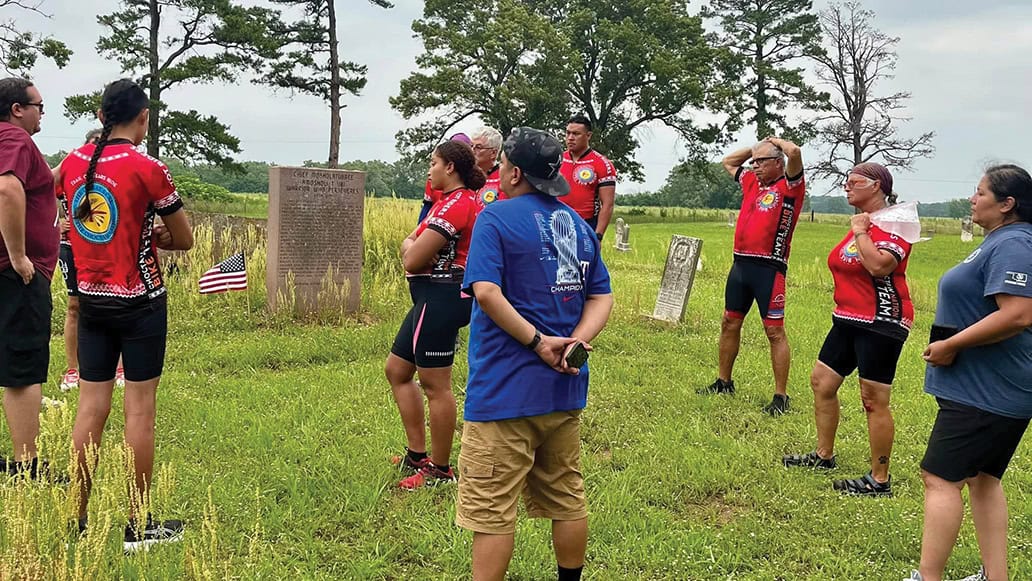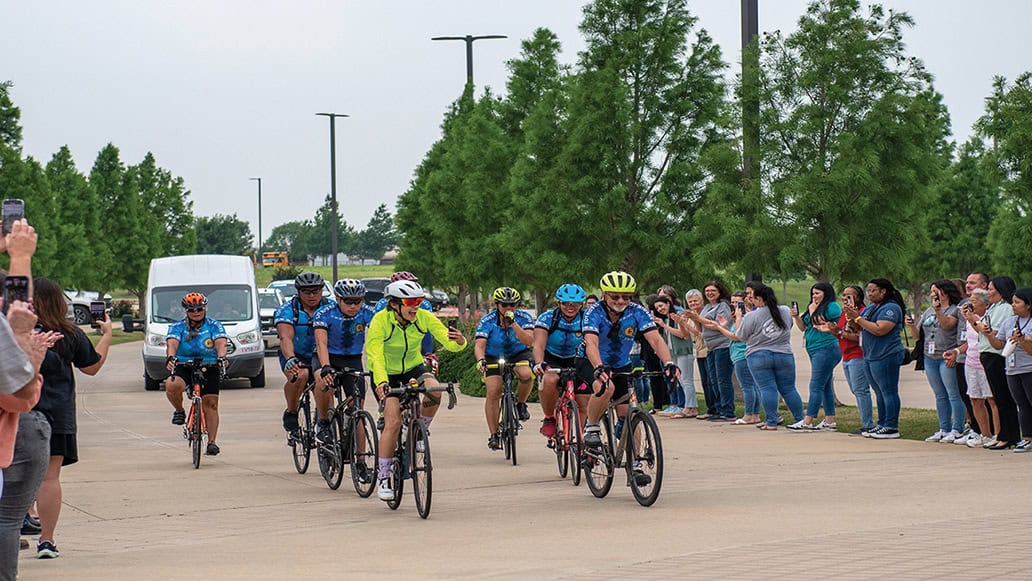
The 2024 Trail of Tears Bike Team is welcomed home by loved ones and coworkers.
Choctaw Trail of Tears Bike Team completes 400-mile ride
Published July 2, 2024By Chris Jennings
Beginning in 1830 and lasting over 70 years, the Choctaw people were forcibly removed from their homelands. While many still don’t know the history of the Trail of Tears, if you’re Native, you’re most likely familiar with it.
You probably know that the Choctaws were the first of the Five Tribes to make the journey—approximately 12,000 people made the trip between 1830 and 1834 alone.
You probably know that thousands of Choctaws didn’t survive the trip, and many lie in unmarked graves along the way. You also probably know that the food and supplies promised were not always there.
It was particularly difficult for the Choctaws due to the U.S. government’s lack of promised supplies and uncoordinated planning throughout the westward journey.
What was planned for by Choctaw leaders, though, was the future of Choctaws for generations to come. When negotiating the Treaty of Dancing Rabbit Creek, the Choctaws were able to secure the new land in Oklahoma in fee simple.
Fee simple is a real estate term that means full and irrevocable ownership of land. Fee simple is the highest form of ownership — it means the land is owned outright without any limitations or restrictions.
Fee simple is what laid the groundwork for the Choctaw people to be able to live in a sovereign nation today. The negotiators knew to do this because of a heavy emphasis on the education of Choctaw and Western traditions. This training in Western law enabled them to use that knowledge to protect Choctaw sovereignty.
Despite signing the 1820 Treaty of Dancing Rabbit Creek, the Choctaws still felt immense pressure to cede more of their ancestral land. The negotiators knew this wasn’t going to stop until they were all dead or their land was taken, with survivors scattered across the country.
Even though most of this is known through stories that have been passed down over generations, the true immensity of the struggle can’t really be conveyed through a story, especially as time goes on. That’s why a group of bicycle riders decided to ride their bikes along the Trail of Tears from Philadelphia, Mississippi, to Durant, Oklahoma.

A big part of the trip’s purpose is education. Rochelle Boykin, one of the ride organizers who’s participated in the ride since 2016, said, “That was our emphasis on this ride. It’s not just to get so many miles and do it within so much time; it’s to incorporate teaching and learning our culture along the way.”
The bike team had its fair share of struggles. Boykin says they had flats and wrecks, contending with storms, riding up mountains and facing 30-mile-an-hour headwinds. Still, these struggles paled in comparison to the struggles faced on the Trail of Tears.
Overcoming those struggles is part of the learning experience. “We know our ancestors had to persevere even more through the tragedy of the loss of loved ones and going through the unfamiliar. New riders felt that and saw that,” said Boykin.”
Colt James, who, at 18 years old, has been the youngest rider for the last two years, said that getting this perspective is an eye-opening experience.
“What we thought at the moment was bad, like ‘this sucks, we’re tired,'” said James. “They had it a whole lot worse.”
Along the way, the riders stopped at various historical sites so that they could learn a little more about their ancestors and what they went through during the Trail of Tears.
Boykin feels that’s an integral part of the journey that helps to teach in a more immersive environment.

“We thought it was hard at the time, but it’s still much easier, much, much easier than what they had to go through,” said James.
“Being able to see and reflect on these historical sites and take in the immensity of what took place while at the same time attempting something difficult for yourself puts the Trail of Tears into a perspective that you don’t get from telling stories or reading about it in a book.
“I think it helps them to understand what our culture and heritage means to us as Choctaw,” Boykin said.
The Choctaw ancestors who signed the Treaty of Dancing Rabbit Creek, which ultimately led to the Trail of Tears, knew the importance of the generations to come. They knew that to preserve the Choctaw Nation, they needed to take steps to guarantee a life for future generations.
“They brought the future for us,” said Boykin. “They brought it when they crossed those Trail of Tears, crossed those rivers, crossed those creeks, and crossed the wooded areas to get to Oklahoma to preserve our future.”